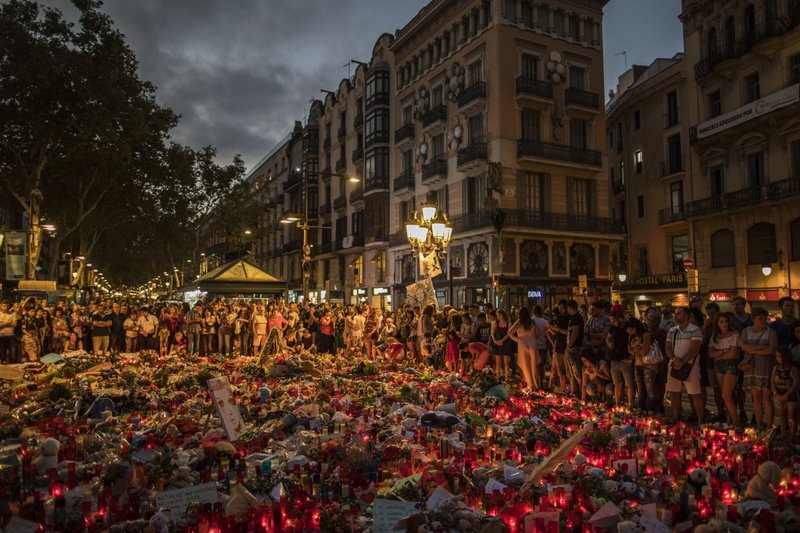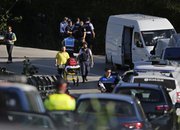SUBIRATS, Spain -- The lone fugitive from the Spanish cell that killed 15 people in and near Barcelona was shot to death Monday after he flashed what turned out to be a fake suicide belt at two troopers who confronted him in a vineyard just outside the city he terrorized, authorities said.
Police said they had "scientific evidence" that Younes Abouyaaqoub, 22, drove the van that barreled through Barcelona's crowded Las Ramblas promenade, killing 13 people on Thursday, then hijacked a car and fatally stabbed its driver while making his getaway.
Besides Abouyaaqoub, the 12-man extremist cell responsible for the violence consisted of Abouyaaqoub's brother and friends and an imam who was one of two people killed in what police said was a botched bomb-making operation.
After four days on the run, Abouyaaqoub was spotted outside a train station about 35 miles west of Barcelona on Monday afternoon. A second witness told police she was certain she had seen the man whose photo has gone around the world as part of an international manhunt.
Click here for larger versions
Photos by The Associated Press
Photos by The Associated Press
Two officers found him hiding in a nearby vineyard and asked for his identification, according to the head of the Catalan police. He was shot to death when he opened his shirt to reveal what looked to be explosives and cried out "Allah is great" in Arabic, said Josep Luis Trapero, the regional police chief.
A bomb disposal robot was dispatched to examine the downed suspect before police determined that the bomb belt was not real, Trapero said. A bag full of knives was found with his body, police said.
A police photo of the body seen by The Associated Press showed his bloodied face, bearing several days' stubble on the chin.
With Abouyaaqoub's death, the group responsible for last week's fatal van attacks has now been broken, Trapero said.
"The arrest of this person was the priority for the police because it closed the detention and dismantling of the group that we had identified," he said.
Four are under arrest, and eight are dead -- five shot by police in the seaside town of Cambrils, where a second van attack left one pedestrian dead early Friday; two others killed on the eve of the Barcelona attack in a botched bomb-making operation; and Abouyaaqoub.
The Islamic State group has claimed responsibility for both the Cambrils and Barcelona attacks.
Roser Ventura, whose father owns a vineyard between the towns of Sadurni d'Anoia and Subirats, said she alerted the regional Catalan police when they spotted a car crossing their property at high speed.
"The police told us to leave the premises and go home. We heard a helicopter flying around and many police cars coming toward the gas station that is some 600 meters from the property," Ventura said.
The search for Abouyaaqoub ended on the same day that Catalan police confirmed that he was the last remaining cell member thought to still be at large and provided a timeline of his movements.
Authorities said earlier Monday they had evidence that pinpointed Abouyaaqoub as the driver of the van that plowed down the Las Ramblas promenade, killing 13 pedestrians and injuring more than 120 others.
Trapero said that after abandoning the vehicle, Abouyaaqoub walked through Barcelona for about 90 minutes, through the famed La Boqueria market and nearly to Barcelona University.
The Spanish newspaper El Pais published images Monday of what it said was Abouyaaqoub leaving the van attack site on foot. The three images show a slim man wearing sunglasses walking through La Boqueria.
In a parking lot often used by university students, he then hijacked a Ford Focus belonging to Pau Perez, stabbing Perez to death and taking the wheel with his final victim's body in the back seat. Minutes later, Abouyaaqoub plowed through a police checkpoint with the stolen car and abandoned the vehicle, disappearing into the night.
The manhunt for him reached well beyond Spain's borders, but in the end, Abouyaaqoub died about 20 miles from where he was last spotted.
After the attack in Barcelona, authorities took a closer look at an explosion the night before in a house in the town of Alcanar, 125 miles south of the city. Police initially had dismissed it as a household accident.
Along with two bodies, the more exhaustive search turned up remnants of over 100 butane gas tanks and materials needed for the the explosive TATP, which has been used previously by Islamic State militants for attacks in Paris and Brussels, among others.
The equipment, along with reports that Abouyaaqoub had rented three vans, suggested the militant cell was making plans for an even more massive attack on the city.
Trapero said it was likely that one of the bodies found at the explosion site was Abdelbaki Es Satty, a Muslim cleric who is suspected of radicalizing young men in the mountain town of Ripoll and organizing the terror cell.
Es Satty, a Moroccan who lived in Ripoll the past two years, served as imam in a local mosque, where he taught the Koran and the Arabic language.
Police said Monday that he was a convicted drug trafficker who had served time in the Castellon prison outside Valencia in 2010 to 2014.
Trapero said the police had no earlier evidence of Es Satty's ties to terrorist groups, but indicated that Es Satty had traveled around Europe.
Ali Yassine, the director of the mosque in Ripoll, said that Es Satty was paid about $1,000 a month to serve as imam. Local benefactors paid his rent and helped with groceries.
Yassine told The Washington Post that he had given Es Satty's name to local police more than a year ago as part of standard security protocol to keep a closer eye on Muslim preachers. But authorities did not flag Es Satty on a watch list even though he had a conviction for trafficking drugs.
Family and friends of the young men, nearly all with roots in Morocco, described them as well-integrated members of the community in Ripoll, a Catalan town nestled into the foothills of the Pyrenees.
"I knew everyone implicated in the attacks. These were people who avoided problems, kept their distance when they saw a fight," said Saber Oukabir, a cousin of two of the attackers.
The group members started spending time with the imam, who police think was their ideological leader, about six months ago, Oukabir said. "I don't know what could have happened, if he manipulated them, if he drugged them or what."
Regional authorities said Monday that 48 people were still hospitalized from the attacks in Barcelona and Cambrils, eight of them in critical condition.
Catalonia's regional president, meanwhile, said regional and local authorities had rejected the Spanish government's suggestion to place traffic barriers to protect the Las Ramblas promenade because they deemed them "inefficient."
Carles Puigdemont told La Sexta television the barriers wouldn't have prevented vehicles from entering the promenade at other points -- and he said closing off Las Ramblas was impractical because emergency vehicles still needed access.
On Monday, crowds of people continued to lay flowers, candles and heart-shaped balloons at the top of the pedestrian promenade where the van struck and at other smaller tributes.
Las Ramblas also regained some normalcy, with throngs of people walking up and down, tourists arriving and residents going about their daily business.
"We have to stand strong in front of these betrayers, assassins, terrorists," resident Monserrat Mora said. "Because Barcelona is strong and they will not be able to prevail with us."
Information for this article was contributed by Joseph Wilson, Aritz Parra, Lori Hinnant, Ciaran Giles and Reda Zeireg of The Associated Press and by William Booth, James McAuley and Brian Murphy of The Washington Post.
A Section on 08/22/2017

